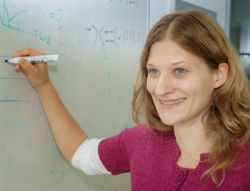
[2013-12-19] The search for Majorana fermions started some time ago and also quantum physicists are now making suggestions for finding the exotic quasi-particles. Junior scientist Christina Kraus and her colleagues have presented two new concepts to proof and potentially use Majorana fermions.
For decades particle physicists have been searching for Majorana fermions. Recently, condensed matter physicists have also started looking for these fermions. Everyone has the same goal: To experimentally proof their existence, which was hypothesised by the Italian physicist Ettore Majorana in the 1930s. The Dirac equation implies the existence of particles that are their own antimatter or antiparticle. There has been some experimental success over the last few years; however, the results are still controversial.
Theoretical physicist Christina Kraus and her colleagues from the Institute for Theoretical Physics at the University of Innsbruck and the Institute for Quantum Optics and Quantum Information (IQOQI) of the Austrian Academy of Sciences have now made a suggestion to proof the existence of Majorana fermions in a system of cold atoms. They also show how these quasiparticles could be used for quantum information processing.
While previous suggestions to realize Majorana fermions with ultracold atoms relied on coupling to an external reservoir, the new concept is better fitted to the experimental possibilities of these many-body systems. “Here two quantum wires each consisting of fermionic atoms are created and coupled in a specific way,” explains Christina Kraus. “We have been able to show that Majorana fermions are realized as edge states in these atomic ladder systems.” In their publication in the journal Physical Review Letters the theoretical physicists also propose an experimental implementation of their theory. “With this new approach we could find and study Majorana fermions,” says the junior scientists.
Information processing with Majorana fermions
In another publication in Physical Review Letters physicist Christina Kraus and her colleagues suggest how Majorana fermions could be used for quantum computation: They propose to create quantum gates via braiding the Majorana fermions. “Compared to other conventional quantum systems, this system is more robust against errors, which is an advantage,” explains Kraus. “However, the disadvantage is that we cannot produce a universal set of quantum lattices with Majorana fermions.” Their proposed concept may still proof that, in principle, topological quantum computers can be realised. To this end, the theoretical physicists suggest a protocol to experimentally implement the Deutsch-Jozsa algorithm by using Majorana fermions. This quantum algorithm was first realized in an ion trap quantum computer in Innsbruck in 2003.
These theoretical concepts proposed by Christina Kraus and her colleagues may help to better understand Majorana fermions. “This is of fundamental importance for physics in general,” says Chrstina Kraus. “The experiments we have suggested could also improve our understanding of topological superconductors and, eventually, open up new avenues for using Majorana fermions in quantum information processing.”
About
Christina Kraus studied physics at the LMU Munich. She wrote her doctoral thesis about quantum information theory under the supervision of Ignacio Cirac at the Max-Planck Institute for Quantum Optics in Garching, Germany. In 2011 she started working with Peter Zoller’s research group in Innsbruck to study fermionic systems.